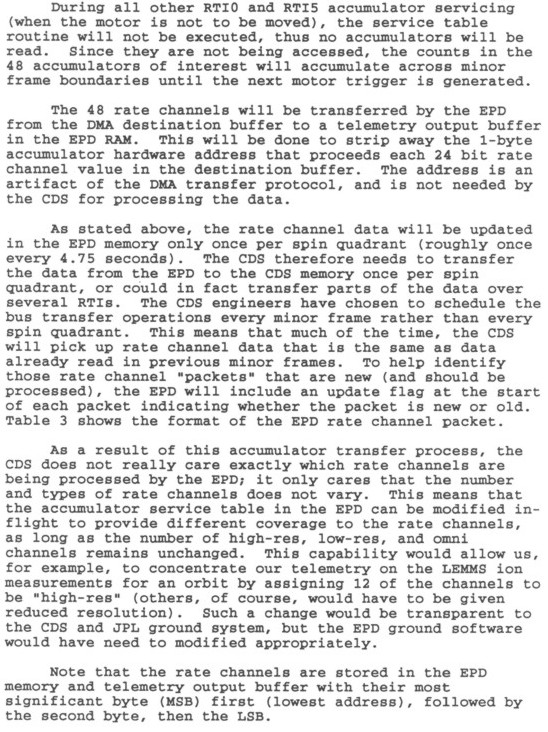The Galileo Energetic Particles Detector
Galileo EPD Handbook
Chapter 2. EPD Software
EPD SBAND Mission Software Requirements (continued)
Source: S. Jaskulek, various dates
EPD Rate Channel Data Processing


Table 3. EPD Rate Channel Packet
| Byte # | Description |
| 1 | b0: Update flag (MSB) 1: new; 0:old b1, b2: Spin quadrant 00:A; 01:B; 10:C; 11:D b3: New spin 0:same; 1:new b4: Map ID 0=MAP1; 1=Map2 b5-b7: Motor position (LSB) 000:Pos.0;...111:Pos. 7 |
| 2, 3, 4 | Rate Channel 1 (24 bits) |
| 5, 6, 7 | Rate Channel 1 (24 bits) |
| 8, 9, 10 | Rate Channel 3 (24 bits) |
| ... | ... |
| 143, 144, 145 | Rate Channel 48 (24 bits) |
| 146 | HV Monitor Value |
| 147-151 | Housekeeping/Status |
| 152-211 | 12 PHA events (20 bits each) and 30
bytes of filler, or 24 PHA events (20 bits each |
Once the data is retrieved by the CDS, it must sequentially go through the 24-bit rate channel values and add them to the proper rate channel bins defined in the CDS memory. The addition algorithm for this may be fairly simple (see Appendix A for more details, but determining which bin to address is not so straightforward. This task will be addressed in section 7.
The motor position, spin quadrant, and motor direction (in the science record status byte), all represent the values present during the quadrant that was just completed. In other words, the motor and spin parameters match up with the rate channel data that is also present in the data for that minor frame. One could expect, therefore, that in a minor frame data packet in which the "new spin flag" is set, the spin quadrant will equal "D."
Next: Telemetry Output Buffers in the EPD Memory
Return to Galileo EPD Handbook Table of Contents Page.
Return to main
Galileo Table of Contents Page.
Return to Fundamental
Technologies Home Page.
Updated 8/23/19, Cameron Crane
QUICK FACTS
Mission Duration: Galileo was planned to have a mission duration of around 8 years, but was kept in operation for 13 years, 11 months, and 3 days, until it was destroyed in a controlled impact with Jupiter on September 21, 2003.
Destination: Galileo's destination was Jupiter and its moons, which it orbitted for 7 years, 9 months, and 13 days.



